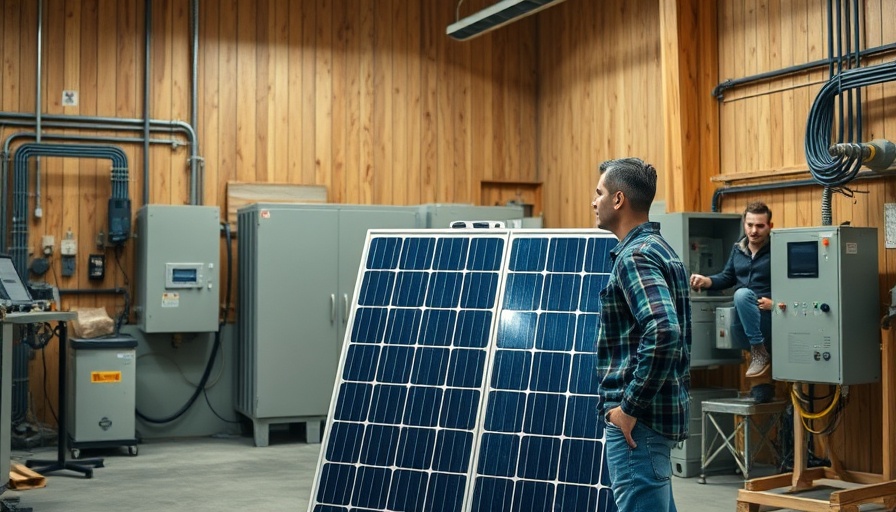
Understanding Backup Power Solutions: A Necessity for Every Home
When considering how to weather the storm—both literally and figuratively—understanding backup power solutions is vital for homeowners, apartment dwellers, and condo residents alike. As we learned from the enlightening video, "A Realistic Guide to Backup Power for Storms," severe weather in the United States leads to an average of 75 major outages each year, affecting up to 15 million customers. Nevertheless, while we cannot control the weather, we can certainly control our preparedness and minimize the impact of power outages.
In "A Realistic Guide to Backup Power for Storms," the discussion dives into the urgent topic of backup power solutions in the face of severe weather, exploring key insights that sparked deeper analysis on our end.
Calculating Your Power Needs Effectively
The initial step in creating a backup power plan is calculating your power needs. The contributors in the Storm Ready video presented an easy equation to help homeowners determine the wattage required for essential appliances: Amps multiplied by Volts equals Watts. For instance, if you have a 60-watt light bulb, it’s clear on the packaging, and thus easy to account for during a power outage. However, for appliances without printed wattage, like a television or refrigerator, using an ampmeter to measure current usage is essential.
Why does this matter? Because knowing the total wattage you'll need allows you to select the most appropriate generator or battery solution for your home. As Dylan and Ira suggest, if you're working from home or want to keep your fridge operational, factoring in startup surges—items that require additional power to start up—like refrigerators, air conditioners, and sump pumps—is key to effective planning.
Portable Gas Generators: A Reliable Choice for Homeowners
For homeowners seeking reliable backup power, portable gas generators stand out as a strong option. These devices come in various sizes and wattage outputs, making it possible to tailor your choice to your specific power needs. As discussed in the video, such generators can offer significant wattage capabilities and are exceptionally versatile—they can be used at home, on camping trips, or during tailgating events.
However, safety is of utmost importance when using gas-powered generators. They must always be positioned at least 20 feet away from structures due to the risk of carbon monoxide emissions. Understanding this safety requirement ensures you can use your generator without compromising the well-being of your household.
Battery Backup Power: A Clean and Efficient Alternative
Another innovative solution for maintaining power is the battery backup system. These portable power stations are silent, emissions-free, and can be charged via wall outlets or even from car batteries. As pointed out in the Storm Ready video, they offer great value during shorter outages and are perfect for keeping essential electronics, medical devices, or smaller appliances powered up without the noise and hassle of gas generators.
What’s more, newer models, like the Jackery Solar Saga 40 Mini mentioned in the video, allow for portability and versatile charging on the go. This means you can keep your devices charged whether at home or out on an adventure.
Whole Home Backup Power: Ensuring Total Peace of Mind
For those willing to invest a little more, whole home backup power systems provide unparalleled convenience. Not only can these setups power your house automatically during outages, but they can also blend with solar energy solutions, creating a sustainable and cost-effective power source. Install your generator hardwired into your electrical panel, and it can instantly switch on when it detects a power failure.
Such an integrated system guarantees minimal disruption in your daily life, allowing you to keep everything running smoothly, from air conditioning to sensitive electronics, even in days of prolonged outages.
Practical Tips for Preparation and Maintenance
The key takeaway from the video is clear: preparation is paramount. Whether you choose a portable generator or a more permanent battery backup solution, keeping devices charged and maintained will significantly reduce the risk of problems during outages. Consider conducting a monthly test of your equipment and draining or stabilizing fuel on your generators during storage. This simple routine can ensure your systems are ready when you need them most.
Conclusion: Empower Your Home Against Power Outages
By thoughtfully considering your power needs and investigating backup power options, you can take proactive steps towards storm readiness. The insights from "A Realistic Guide to Backup Power for Storms" open doors to a multitude of choices available for maintaining vital power during outages. Choose wisely, plan effectively, and empower your home with the backup solutions that best fit your lifestyle and needs.
Exploring your options can make all the difference before the next storm hits—take action now to ensure your family's safety and comfort wherever you may be. Stay informed and ready!
 Add Row
Add Row  Add
Add 




Write A Comment